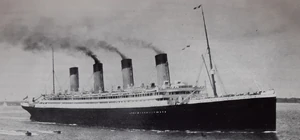The RMS Olympic, also known as "Old Reliable" was a British ocean liner that sailed for the White Star Line from 1911 till 1935. She was the largest ship of her time in 1911. She was a triple-screw steamer, 890 feet long with 4 funnels.
She had a successful Maiden Voyage that began on June 14, 1911 and ended June 21, 1911. She was a sister ship of the Titanic and the Britannic, the first of the Olympic-Class to be built by the Harland & Wolff shipyard in Belfast. In 1935, she ended her service and was sold to be scrapped. The demolition was completed in 1937.
Her first year[]
The Olympic was involved in an accident with a navy battlecruiser, the HMS Hawke. Both ships got seriously damaged. Olympic limped back home with a gaping hole and two breached compartments at the aft and was repaired, which delayed Titanic's Maiden Voyage to March as some workmen were needed. Olympic was involved in another accident in 1912 and once more, Titanic's completion was postponed and planned to be in the beginning April.
Titanic's cry for help[]
Olympic received distress calls from her doomed sinking sister, RMS Titanic. She 500 miles away, too far for Olympic to assist her in time. Nevertheless, her captain, Herbert Haddock tried to come as fast as the Olympic could, lighting all boilers to get to her topspeed of 24 knots. He had contact with the Carpathia who was the first ship to arrive at the scene one and a half hour after Titanic's demise. He offered to come and help take survivors on board Olympic as Carpathia was far smaller, but he was told off by Captain Arthur Rostron, as he believed the sight of Olympic, which was so similar to Titanic in many ways, would scare and traumatise the survivors of Titanic, who saw a similar ship disappear beneath the surface. In the end, it would have taken Olympic a whole day to reach the wrecksite anyway, so Olympic commenced on her normal schedule.
World War I[]
Olympic was refitted as a troop transport in early 1915. She sunk a German U-boat in 1918 and got awarded later for her outstanding service.
Post World War I[]
In 1934, Olympic sunk a Nantucket lightship by mistake as she couldn't see it until it was too late. Her prow ran straight over the small vessel.
Retirement[]
She was decommissioned in 1935 after aging and to make way for new ships, she was sold to a British ship scrapper in 1936 and she was scrapped the following year, 1937. Most of her fittings were given new life and were re-used at the White Swan Hotel in Alnwick, Northumberland, like her elegant First Class Lounge. The À la Carte Restaurant can be found on a cruise ship, the Celeberity Millennium. The hull was last seen at a junkyard in Jarrow, where she was scrapped.
